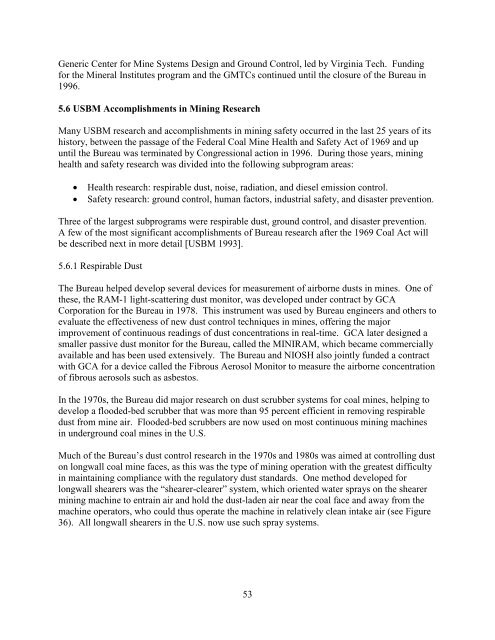One Hundred Years of Federal Mining Safety and Health Research
One Hundred Years of Federal Mining Safety and Health Research
One Hundred Years of Federal Mining Safety and Health Research
- No tags were found...
Create successful ePaper yourself
Turn your PDF publications into a flip-book with our unique Google optimized e-Paper software.
Generic Center for Mine Systems Design <strong>and</strong> Ground Control, led by Virginia Tech. Funding<br />
for the Mineral Institutes program <strong>and</strong> the GMTCs continued until the closure <strong>of</strong> the Bureau in<br />
1996.<br />
5.6 USBM Accomplishments in <strong>Mining</strong> <strong>Research</strong><br />
Many USBM research <strong>and</strong> accomplishments in mining safety occurred in the last 25 years <strong>of</strong> its<br />
history, between the passage <strong>of</strong> the <strong>Federal</strong> Coal Mine <strong>Health</strong> <strong>and</strong> <strong>Safety</strong> Act <strong>of</strong> 1969 <strong>and</strong> up<br />
until the Bureau was terminated by Congressional action in 1996. During those years, mining<br />
health <strong>and</strong> safety research was divided into the following subprogram areas:<br />
• <strong>Health</strong> research: respirable dust, noise, radiation, <strong>and</strong> diesel emission control.<br />
• <strong>Safety</strong> research: ground control, human factors, industrial safety, <strong>and</strong> disaster prevention.<br />
Three <strong>of</strong> the largest subprograms were respirable dust, ground control, <strong>and</strong> disaster prevention.<br />
A few <strong>of</strong> the most significant accomplishments <strong>of</strong> Bureau research after the 1969 Coal Act will<br />
be described next in more detail [USBM 1993].<br />
5.6.1 Respirable Dust<br />
The Bureau helped develop several devices for measurement <strong>of</strong> airborne dusts in mines. <strong>One</strong> <strong>of</strong><br />
these, the RAM-1 light-scattering dust monitor, was developed under contract by GCA<br />
Corporation for the Bureau in 1978. This instrument was used by Bureau engineers <strong>and</strong> others to<br />
evaluate the effectiveness <strong>of</strong> new dust control techniques in mines, <strong>of</strong>fering the major<br />
improvement <strong>of</strong> continuous readings <strong>of</strong> dust concentrations in real-time. GCA later designed a<br />
smaller passive dust monitor for the Bureau, called the MINIRAM, which became commercially<br />
available <strong>and</strong> has been used extensively. The Bureau <strong>and</strong> NIOSH also jointly funded a contract<br />
with GCA for a device called the Fibrous Aerosol Monitor to measure the airborne concentration<br />
<strong>of</strong> fibrous aerosols such as asbestos.<br />
In the 1970s, the Bureau did major research on dust scrubber systems for coal mines, helping to<br />
develop a flooded-bed scrubber that was more than 95 percent efficient in removing respirable<br />
dust from mine air. Flooded-bed scrubbers are now used on most continuous mining machines<br />
in underground coal mines in the U.S.<br />
Much <strong>of</strong> the Bureau’s dust control research in the 1970s <strong>and</strong> 1980s was aimed at controlling dust<br />
on longwall coal mine faces, as this was the type <strong>of</strong> mining operation with the greatest difficulty<br />
in maintaining compliance with the regulatory dust st<strong>and</strong>ards. <strong>One</strong> method developed for<br />
longwall shearers was the “shearer-clearer” system, which oriented water sprays on the shearer<br />
mining machine to entrain air <strong>and</strong> hold the dust-laden air near the coal face <strong>and</strong> away from the<br />
machine operators, who could thus operate the machine in relatively clean intake air (see Figure<br />
36). All longwall shearers in the U.S. now use such spray systems.<br />
53
















